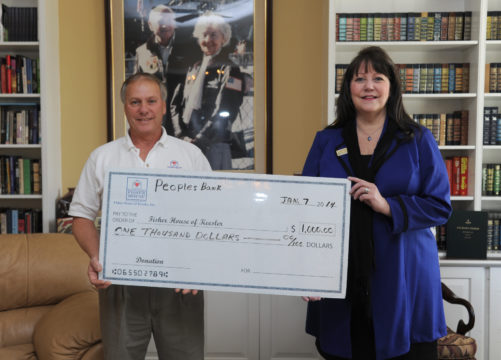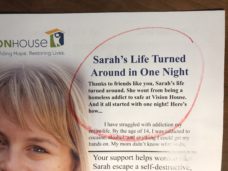It is newsletter season!
I’m hearing from lots of organizations who are working on their next newsletter. Either all these folks are upstanding and know their donors deserve to be Reported to, or they are smart because they know they’ll raise money and retain more of their donors if they Report. Hopefully both!
In a slight departure from the norm, this is a list of what not to do. Because sometimes knowing what not to do is more helpful than knowing what to do. So here’s a list of things to leave out of your newsletter.
Will any one of these things kill your response and drive donors away? No. But if you want to make a newsletter that more donors will read, and help you get future donations, you’ll eliminate as many of these as you can …
What to leave out of your newsletter
- Photos of people giving or receiving big checks.
- Photos of more than 3 people.
- Any articles about: how great your organization is, awards won, certifications garnered, or statistical comparisons. There is one exception: if you can frame the story around a donor benefit, then it can be helpful for donors. For instance, the headline of a story about “Our Programs Among Most Effective In Nation” could be reframed to say “Proof That Your Gift Is Effective.” It’s that way of thinking that can take your newsletter from self-congratulatory advertising to a donor-retaining and money-raising publication.
- Any articles about the organizations that you partner with.
- Stories where there’s more information about your program or staff than about the beneficiary.
- Any article or story that doesn’t mention the donor.
- Type that’s too small to be easily read by a 70-year-old.
- Anything written above a 10th grade level. (This isn’t about donor intelligence, folks. It’s about ease of readability. Because ease of readability is directly related to fundraising results. Easier to read and understand quickly? Raise more. More complex writing with a light sprinkling of jargon? Raise less.)
- The word “we” and; “us” and; “our.” (You can actually have a couple of these, but try to have one of them for every three times you say “you” and; “your.” Remember, the most effective newsletters are about what your donor did, not what your organization did.)
- The words “partner” and “partnering.”
- Headlines that don’t tell your donor anything useful. (Most people will only read your headlines and picture captions. Make sure those two things communicate the message you’re trying to send!)
The pushback, and the answers
When we work with our clients, or speak at conferences, there are two pieces of pushback we get all the time from this list. Here they are, along with our responses.
“But wait, how will our volunteers/clients/partners know about the volunteer opportunity/where to go to sign up/how to work with us?”
The answer: If you want your newsletter to be worth the time and money to create, it needs to be only for donors. Most likely, you need a different publication for your non-donor audiences. Over time, we’ve seen that newsletters that are aimed at donors AND other audiences do not effectively Report to donors (and tend to harm overall fundraising). So you have to make a hard choice and make your newsletter about your donors. And only send your newsletter to your donors.
“But wait, if we don’t tell them in our newsletter, how will our donors know how great and effective we are?”
The answer: an effective newsletter absolutely tells your donors how great and effective you are, it just does it differently than most organizations are used to. Here’s why. Most donors are not asking themselves if your organization is great and effective. (Are some foundations and some major donors asking that? Of course). Most donors are asking a much simpler question. They are wondering, “Did my gift make a difference?” We’ve done hundreds of newsletters and the results are really clear. Showing your donor how her gift made a difference is FAR more effective for fundraising results (both short- and long-term) than showing her how great and effective your organization is. Because for a donor, showing her that her gift made a big difference is how you show her how great and effective your organization is.
Short, sweet summary
Your newsletter should be an exercise in giving credit away. Focus on what your donor did, not on your role. It works in friendship, and it works in fundraising!
Steven Screen is Co-Founder of The Better Fundraising Company and lead author of its blog. With over 30 years' fundraising experience, he gets energized by helping organizations understand how they can raise more money. He’s a second-generation fundraiser, a past winner of the Direct Mail Package of the Year, and data-driven.









Can you clarify more with what you mean by not using the terms “partner” or “partnering”? Is that just in relation to partner organizations? We typically stay away from “donors” when speaking externally because we don’t want people to think we just look at them as cash machines. We usually do refer to them as our “partners”.
Thanks for your question! In a nutshell, the vast majority of donors don’t think of themselves as “partners” or as “partnering” with your organization. They think of themselves as ‘helping people’ or something similar. So, saying “Thank you for partnering with us as we raise children out of poverty” is less powerful for a donor to hear than “Thank you for raising children out of poverty.” This is what I meant at the bottom of the post: “Your newsletter should be an exercise in giving credit away. Focus on what your donor did, not on your role.” Don’t mention your organization, don’t mention your donor’s relationship to your organization, just focus on what they (or their gift) did; raise a child out of poverty (taken from your website). Does that help?
That does help. Thank you! I don’t know that we’ve looked at it that way much before, but will moving forward!